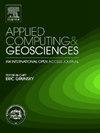利用卫星SAR图像快速绘制滑坡地图:渐进式学习方法
IF 3.2
Q2 COMPUTER SCIENCE, INTERDISCIPLINARY APPLICATIONS
引用次数: 0
摘要
在异常事件发生后迅速发现山体滑坡对于规划有效的灾害管理至关重要。以前的工作通常使用基于机器学习的方法,包括最近流行的深度学习方法,从卫星遥感数据(特别是光学图像)中识别特征表面特征。然而,在多云条件下,从光学图像中获取数据是不可能的,这会导致未来事件的任何映射任务出现不可预测的延迟。这些方法还依赖于大量的人工标记的培训清单,而这些清单在事件发生之前通常是不可用的。在这项工作中,我们提出了一种主动训练策略,在事件发生后使用第一张可用的合成孔径雷达(SAR)图像生成滑坡地图,并在获得后续无云光学图像后对其进行改进。提出的主动学习工作流可以从一个小的(~ 100m2)和不完整的库存开始,并且可以在迭代步骤中增加范围和完整性,在每个步骤之后进行手动更新。这大大减少了生成大型训练清单所需的缓慢的手动映射。我们设计了实验,按照获得的顺序使用ALOS-2 (SAR)和PlanetScope(光学)场景绘制2018年日本北海道东伊武里6.6级地震引发的山体滑坡。主动学习的选择优先考虑速度而不是准确性。然而,我们注意到只有适度的性能下降(F1和MCC分数下降约10%),我们的方法允许在一天内完成初步的滑坡清单。这在灾难响应、提高性能和减少与手工绘图相关的潜在主观性方面非常重要。本文章由计算机程序翻译,如有差异,请以英文原文为准。
Rapid mapping of landslides using satellite SAR imagery: A progressive learning approach
Rapid detection of landslides after an exceptional event is critical for planning effective disaster management. Previous works have typically used machine learning-based methods, including the recently popular deep-learning approaches, to identify characteristics surface features from satellite remote sensing data, especially from optical images. However, data acquisition from optical images is not possible in cloudy conditions, leading to unpredictable delays in any mapping task from future events. These methods also rely on large manually labelled inventories for training, which is often not available before the event. In this work, we propose an active training strategy to generate a landslide map after an event using the first available synthetic-aperture radar (SAR) image and improve it once subsequent cloud-free optical images are acquired. The proposed active learning workflow can start with a small () and incomplete inventory,- and can grow the extent and completeness in iterative steps with manual updates after each step. This significantly reduces the slow manual mapping typically required for generating a large training inventory. We designed our experiments to map the landslides triggered by the 6.6 Hokkaido Eastern Iburi earthquake of 2018 in Japan using sequentially ALOS-2 (SAR) and PlanetScope (Optical) scenes in the order they are acquired. The choice of active learning prioritizes speed over accuracy. However, we note only a modest reduction in performance ( drop in F1 and MCC scores), with our method allowing a preliminary landslide inventory to be completed within a single day. This is of major importance in disaster response, improving performance and reducing the potential subjectivity associated with manual mapping.
求助全文
通过发布文献求助,成功后即可免费获取论文全文。
去求助
来源期刊

Applied Computing and Geosciences
Computer Science-General Computer Science
CiteScore
5.50
自引率
0.00%
发文量
23
审稿时长
5 weeks
 求助内容:
求助内容: 应助结果提醒方式:
应助结果提醒方式:


